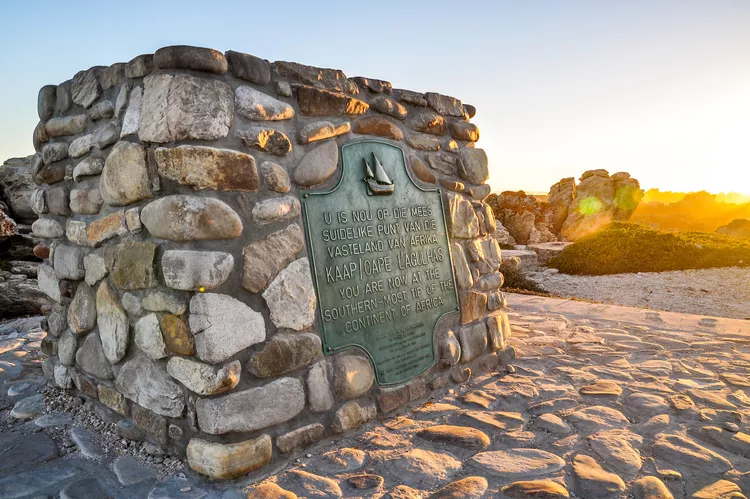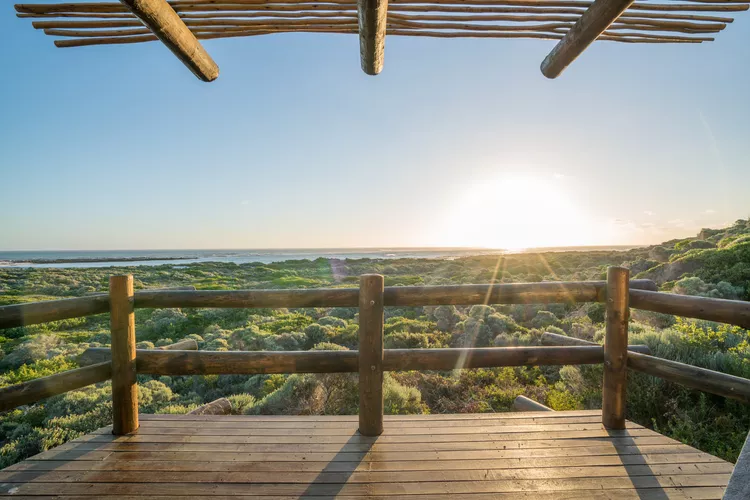

Cape Agulhas, South Africa: The Complete Guide
Travel roughly 140 miles southeast of Cape Town in South Africa and you will reach Cape Agulhas, the most southerly point on the African continent. Once known as the Cape of Storms, the peninsula was infamous amongst early colonial explorers, many of whom wrecked their ships upon its treacherous coastline. Its current name comes from the Portuguese meaning “Cape of Needles” and today, it’s best known to visitors as a place of untamed beauty. Come to explore its natural and cultural wonders, and to gaze out at the vastness of two oceans spreading uninterrupted towards Antarctica with the entire African continent at your back.
History of Cape Agulhas
Cape Agulhas is a place of considerable geographic and cultural significance. As well as being the southernmost tip of Africa, it is also the place where the Indian and Atlantic Oceans officially meet. In addition, the area surrounding the cape is a haven for botanists as part of the Cape Floral Kingdom–the smallest (and richest) of six global plant kingdoms. More than 2,000 indigenous plant species grow here, including many different types of coastal fynbos that are found nowhere else on Earth. One hundred and ten Cape Agulhas plant species are rarities listed on the IUCN Red List, while many of them provide food and shelter for a wealth of animal and birdlife.
People have also left their mark on the Agulhas Plain. Archaeological findings including stone fish traps, hearths, pottery, and shell middens date back to the time of the Khoisan (one of Southern Africa’s oldest indigenous people), while local shipwrecks tell the tale of ill-fated colonial-era exploration. The remnants of many of these wrecks can be viewed at the Shipwreck Museum in the nearby town of Bredasdorp, including artifacts from the HMS Birkenhead whose tragic sinking inspired the nautical code of honor, “women and children first.” The wreck of a Japanese ship, the Meisho Maru 38, is still visible on the Cape Agulhas shoreline.
As a result of its rich biodiversity and fascinating human history, the area was protected under the auspices of Cape Agulhas National Park in 1998.

The Top Things to See and Do
For most visitors, the park’s main attraction is the southernmost tip of Africa which is marked by a cairn adorned with a plaque inscribed in Afrikaans and English. The cairn makes for one of the country’s most recognizable photo opportunities. Besides the southernmost point, there are plenty of other things to do at Cape Agulhas:
Cape Agulhas Lighthouse: Built in 1849 in an attempt to curb the region’s tally of fatal shipwrecks, the Cape Agulhas Lighthouse is constructed from locally quarried limestone. It is the second-oldest working lighthouse in Southern Africa, and has a museum for visitors and 71 steps that lead to the top for magnificent ocean views.
Hiking and Fishing: Cape Agulhas National Park is a natural fit for lovers of the great outdoors. You can explore many of its highlights on one of two designated walking trails. The circular Two Oceans trail takes you through indigenous fynbos to a viewpoint that overlooks the Atlantic and Indian Oceans, and has a total length of 6.5 miles. It can be divided into two shorter trails and is open to overnight visitors only.
The Rasperpunt trail is named for the ancient Khoisan fish traps that were built of stone and are still visible just to the east of the lighthouse. It’s a 3.5-mile circuit along the coastline and through the fynbos that starts and ends at the wreck of the Meisho Maru 38. If you want to fish en route, rock and surf permits can be purchased from the Struisbaai post office.
Wildlife Viewing: Unlike many of South Africa’s other national parks, there are relatively few terrestrial mammals at Cape Agulhas; though the coastal fynbos is home to the diminutive and endemic Cape grysbok antelope. The majority of wildlife viewing is ocean-based, with Cape fur seals, dolphins, and whales all frequently spotted from shore. Southern right whales migrate past the point every year from June to November.
Birding: The incredible diversity of plant species at Cape Agulhas also results in an impressive array of birdlife. Wetland areas across the Agulhas Plain attract an estimated 21,000 migrant and resident wetland birds each year; while the Springfield Saltpan hosts large flocks of lesser and greater flamingo. Look for the nesting sites of endangered African black oystercatchers on the beach, Cape sugarbirds and sunbirds in the fynbos, and the vulnerable hottentot buttonquail in the Renosterveld.
Weather and Best Time to Visit
Cape Agulhas has a Mediterranean climate with hot, dry summers and cool, wet winters. Remember that seasons in South Africa are reversed from those in the northern hemisphere, so that winter lasts from June to August and summer is from December to February. The mean annual temperature is 59 degrees F (15 degrees C), while winter nights frequently get as cool as 44 degrees F (7 degrees C). Many people choose to visit in spring, summer, or fall for the best weather (and optimum conditions for hiking, beach visits, and photography). A popular mountain bike race called the Cape Agulhas Classic takes place in the park every December; while winter and early fall are the only times to travel if you want to catch the southern right whale migration.

Getting There
You will need your own vehicle to reach Cape Agulhas since it’s not accessible via public transport. From Cape Town, it’s a three-hour drive. Take the N2 highway out of the city, then turn southeast onto the R316 at Caledon and finally southwest onto the R43 at Bredasdorp to reach the national park. If you’re coming from the Garden Route in the east, follow the N2 highway until you get to Swellendam. Then, turn southwest onto the R319 to Bredasdorp and from there take the R43 to the park. Cape Agulhas can also be reached via a scenic gravel road that travels along the coast from the nearby town of Gansbaai.
Where to Stay
There are three separate South African National Parks (SANParks) camps within Cape Agulhas National Park. The eco-friendly Agulhas Rest Camp offers five family units with two en-suite bedrooms and 10 single units with one bedroom and an open-plan kitchen and lounge. All 15 units are equipped for self-catering with a kitchen and all utensils; and a South African braai area outside for barbecues. The rest camp area also boasts the 19th-century, four-bedroom Lagoon House for extended families or groups of friends that want both privacy and astonishing sea views.
Other options for those that like to get off the beaten track include Rhenosterkop Rest Camp and Bergplaas Guest House. The former is a collection of three historic cottages on a farm that dates back to 1742, located in the Strandveld and there is a 45-minute drive from reception along a gravel road. The latter overlooks rolling mountain foothills and has five bedrooms (for rent separately or as a whole) as well as a full kitchen, living room, and dining room. Bergplaas Guest House is also located on a gravel road and high-clearance vehicles are recommended.
Things to Do Nearby
If you want to extend your visit, there are plenty of amazing places to visit within an hour or two of Cape Agulhas. Wine connoisseurs should head to the tasting room, restaurant, and deli at Black Oystercatcher Winery for a chance to sample unique cool-climate wines in between Bredasdorp and Elim. Nearby Gansbaai is famous as the world’s cage-diving capital for those that want to come face-to-face with great white sharks; while the Breede River is one of the best destinations in South Africa for fishing. For wildlife viewing, visit De Hoop Nature Reserve, Bontebok National Park, or Hermanus (one of the best land-based whale-watching destinations on Earth).
Practical Information for Visitors
All visitors to Cape Agulhas must register at the SANParks reception, which is located at 214 Main Road in L’Agulhas. It is open from 7:30 a.m. to 6 p.m. Monday through Friday, and from 9 a.m. to 5 p.m. on weekends and public holidays. Overnight guests can request to check in outside office hours, but only if they make arrangements at least one day in advance. All guests must pay a daily conservation fee of 192 rand per adult and 96 rand per child. Discounts are available for South African citizens and residents and SADC nationals. Facilities including restaurants, shops, and ATMs do not exist within the park but can be found in the nearby towns of L’Agulhas, Struisbaai, and Bredasdorp.

